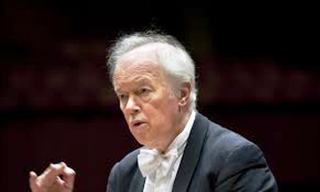|
Back
Memories of Denmark New York
David Geffen Hall, Lincoln Center
11/30/2017 - & December 1*, 2, 2017
Bent Sørensen: Evening Land (World Premiere)
Wolfgang Amadeus Mozart: Piano Concerto No. 20 in D minor, K. 466
Johannes Brahms: Symphony No. 2 in D Major, opus 73
Emanuel Ax (Pianist)
New York Philharmonic, Edo de Waart (Conductor)

E. de Waart
”I am looking out of the window, and there is a very special evening light over the fields. Far away there are trees and a cow. It is as if the world is infinite.”
From Bent Sørensen’s program notes for Evening Land
Not the zeitgeist, but perhaps the land-spirit did that quote from the composer male sense. For when looking out the second-floor window of Carl Nielsen’s tiny home in Denmark, you see endless pastures, a few trees, even a cow.
And when listening to the bucolic opening measures of Bent Sørensen’s Evening Land, commissioned by the New York Philharmonic, you feel exactly the same mood given by Nielsen in his Helios Overture, a mood of calm and repose, the mood of a composer who has mastered his sense of the pictorial and the orchestra.
His teacher, after all, was Per Nørgård, recipient of the Philharmonic’s Marie-Josée Kravis Prize for New Music. Nørgård, instead of composing music for the Phil, suggested Bent Sørensen, and Sørensen, a master of evocative imagery apparently leaped at the chance. His inspirations were two: First, that childhood memory from the Danish island of Zeeland (Nielsen’s village was Norre Lindsle, on the mainland), and second–a most unlikely inspiration–the spirit of Leonard Bernstein, who he had heard in New York many years ago.
That didn’t quite pare together.. From the idyllic opening, with a soft solo by acting Concertmaster Sheryl Staples, the orchestra went almost directly into something close to West Side Story’s “Mambo”, with drums pounding, with expectations of the whole Phil shouting out the words.
Bent Sørensen could have had a pleasant two-sectioned work, but he dove into more original elements. Some gorgeous string chorales, an oboe solo, more activity and an unexpectedly low-key ending.
Initially, while enjoying the individual moments, I wondered about the ungainly structure. Then came the realization that the composer was perhaps creating a dream, where logic is the least important element. And in that, he succeeded with some jewel-like textures, with a pulsing rhythm when necessary, and yes, that Nielsen sense of nostalgia for a childhood past.
The work was conducted by one of the great stalwarts of the concert stage, Edo de Waart. He is such a seasoned performer that his performance of the Brahms Second Symphony should have been a thing of comfort and joy. That wasn’t quite the picture last night. The Philharmonic wasn’t quite off its game, but the balance wasn’t right. The horns were loud, the strings were sometimes off balance in the first movement.
The next movement was graceful enough, and the finale brought the Phil to its exuberant best, with the kind of Bernstein-like whipping which they enjoy so much.
Finally, we come to Emanuel Ax, who has obviously played the Mozart 20th Concerto all too often. Mr. Ax is never a pianist who takes things for granted, and always gives the best possible show (without ever being the showoff).
And yes, those scales were silken smooth, the poetry of the Romance was as limpid as the cliched spring, and the finale brought forth some jocund moments.
Strangely, the best part by far wasn’t Mozart, who had never written out a cadenza for the Concerto. Thus, Mozart’s son, Franz Xavier, Clara Schumann, Brahms, and Busoni tried their hands at it. But Beethoven’s cadenza was not only the best–but in this rather placid performance, it provided the most electric moments.
Beethoven made not the slightest effort to make it Mozart. This was Beethoven of the Waldstein, of the Pathétique, with intimations of later string quartets. It was wild and dissonant, it went in various directions–and best of all, it inspired Emanuel Ax to play the work as it should be played.
For the record, Johann Hummel wrote the last-movement cadenza, which was a pedagogical challenge that Mr. Ax, as ever, played with both fluency and delight.
Harry Rolnick
|